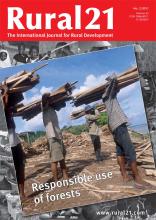Land Library
Welcome to the Land Portal Library. Explore our vast collection of open-access resources (over 74,000) including reports, journal articles, research papers, peer-reviewed publications, legal documents, videos and much more.
/ library resources
Showing items 244 through 252 of 394.On November 18th 2010, the European Union Commissioner for Agriculture and Rural Development, Dacian Ciolo?, o? cially submitted a communiqué proposing a reorientation of the Common Agricultural Policy (CAP) to the EU Parliament, the EU Council and the public.
Zambia’s small-scale farmers are even poorer today than they were 40 years ago. According to the 2010 Human Development Report, Zambia is one of just three nations whose development has fallen behind 1970 levels.
Carbon labels for food are a new strategy of industrialised countries to reduce climate change-relevant gas emissions in agriculture. However, not every label includes the measurement of all emissions and may disadvantage and even exclude exporting farmers from developing countries.
Cassava is the main staple crop in many African countries, but the crops are threatened by two major diseases, the cassava mosaic virus disease and cassava brown streak virus, which in the last years have destroyed almost 80 percent of cassava harvests in Africa.
King prawns are a delicacy worldwide, but some breeding processes are responsible for extensive environmental damage, especially in mangrove forests. The widespread use of antibiotics also has a negative impact on human health. The cultivation of 'organic prawns' could be a real alternative.
Livestock intensification in developing countries, especially in Africa and Asia, may increase the incidence of epidemics that kill both humans and animals, the International Livestock Research Institute (ILRI) warns.
In January 2011 the South African Institute of International Affairs (SAIIA) launched an online knowledge resource offering researchers and opinion leaders easy access to research and information on Africa.
In response to the 2008 food crisis, Senegal developed an ambitious food self-sufficiency programme which aims to entirely cover national rice consumption needs with local rice by 2015, mainly through massive investments in existing and new rice perimeters in the Senegal River Valley (SRV).
Rural development and urbanisation are often seen as competing, but in most cases are intimately linked. It is essential that policies re? ect and support the many positive links between rural and urban areas, enterprises and people.


